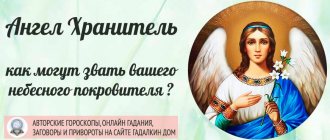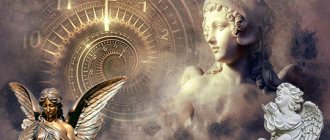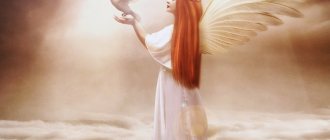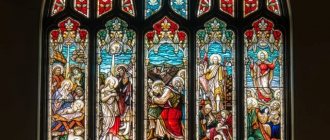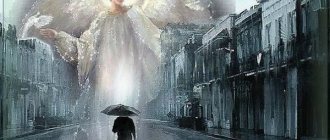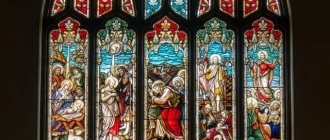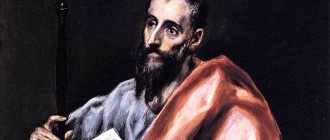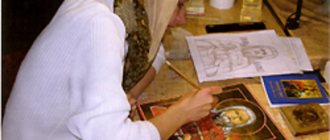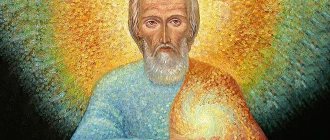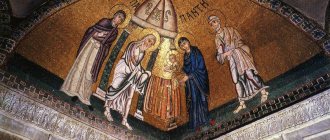Angels in Orthodoxy
Who are angels? And why is the Guardian Angel icon needed? Christianity teaches that angels are disembodied spirits residing in the spiritual world invisible to us (the souls of dead people are also located there). The Almighty created them even before the creation of the Universe and man. These are intelligent beings with free will. Since angels do not have a physical body, they do not experience material needs.
Guardian Angel Icon
The purpose of angels is to serve the Almighty. However, not all spirits remained faithful to Him. One of the main angels, Dennitsa, abused his freedom, became proud and wanted to take the place of the Creator. With the help of lies and for reasons of pride, he enticed some other spirits with him. There was a confrontation between the heavenly army faithful to God and those who chose the path of evil. The latter were expelled from God's world. The place of their subsequent stay is called hell.
Fallen angels are called demons and demons, and Dennitsa became Satan (the devil) - translated from Hebrew as “the enemy” of God. They all hate the Creator and His main creation - people. Therefore, demons seek to destroy our souls. Metropolitan Hilarion Alfeev notes:
“All the efforts of evil spirits are aimed at resisting the will of God, turning people away from the true faith and from following the Divine commandments.”
Good angels carry out the will of God, resist demons and try to protect people from their influence. These spirits remain pure, sinless creatures who love God and people. Angels are outside of time and space; they are able to influence our material world.
The Church also teaches about the hierarchy of the heavenly host. There are various ranks of angels: archangels, seraphim and cherubim. Their mentions are present in the Holy Scriptures. For example, from the Archangel Gabriel, the Virgin Mary learned that she would become the mother of the savior of mankind - Jesus Christ.
Finding your own holy spirit icon
During baptism, the child receives a name, and together with the patron saint, a specific Guardian Angel is assigned to him. More often this procedure is carried out during Christmas time (the period from Christmas to the Baptism of the Son of God). However, the Church allows the ritual of unification with the heavenly protector to be performed arbitrarily if the person was baptized in adulthood.
In Christian calendars, several patrons may be celebrated with a date that will be close to the birthday of a small child. In this case, you are allowed to independently choose the patron you like.
Some images of holy protectors have several variations in execution in their iconography. The saint always helps children with the same name. When choosing a patron, you should rely on dates of birth or biography facts.
For the Orthodox tradition, spiritual kinship is closer, which is determined by sympathy.
On a note! If you are inspired by the life deeds of a particular saint, the church allows you to make him your patron. He is a real person who was canonized by the church (Virgin Mary, Seraphim of Sarov, etc.).
Guardian angel
The Holy Guardian Angel is given to a person by God during the Sacrament of Baptism. This angel is called to accompany a Christian on his life's path, protecting him from the influence of the devil and sin. Let us quote the words of the holy righteous John of Kronstadt:
“If there were no Guardian Angels, then demons would destroy the entire human race. The malice of demons towards people is immeasurable and their envy towards man has no limits, for man was created in the image of God and destined for the inheritance of eternal life in the place of the fallen angels.”
Also, an invisible good spirit helps its ward in performing virtues and spiritual development. The Guardian Angel brings our prayers to the Lord and himself prays for us. The heavenly patron does everything to save the soul entrusted to him. Saint John Chrysostom teaches:
“Angels not only protect but also guide believers so that they do not stumble.”
The Guardian Angel is a person’s companion in the afterlife. At the Last Judgment, a good spirit will intercede for the soul before the Lord. And if the soul is saved, then the angel will become its best friend in Paradise.
However, Orthodox Christians should remember that the Guardian Angel cannot help a person who does not make efforts for his own salvation. If the soul has forgotten about God and does not fulfill His commandments, then the angel departs from it with sadness. Priest Svyatoslav Shevchenko explains:
“We are created with free will, which neither God nor, especially, His Angels will violate.”
Those who are looking for information about what the “guardian angel” icon is, what its meaning is, and how it helps, should remember a common mistake. It consists in identifying the Guardian Angel with the Orthodox saint whose name the person is named. Confusion is also caused by the fact that name days are often called Angel's Day. However, a saint and an angel are two different personalities who protect a person. There are separate prayers for addressing each of them.
Guardian Angel as a personality and problems of his depiction in Orthodox iconography
Images of Angels can already be found in the Roman catacombs, although without the usual wings. Although winged creatures are known even in pre-antique times. However, in early Christian monuments there are no images of the Guardian Angel.
Guardian angel. Proris V.V. Filatova.
His iconography, which spread from the 16th to 17th centuries in Russia, usually presents us with “a young man dressed in a white tunic, sometimes in a tunic and himation, or a cloak, the main attributes being a cross and a naked sword”[1].
No matter how much we searched, we never found the iconography of the Guardian Angel in 11th-century Byzantine art, fundamental to the Orthodox world. That “temple guard” from Sofia of Constantinople, which is mentioned by Fr. Georgy Florovsky[2], is, according to V.N. Lazarev, Archangel Gabriel[3], which is much more like the truth. The measure and mirror in our hands testify: before us is one of the Archangels, but not the “guardian of the temple.”
The heavenly powers were depicted quite often, but not the Guardian Angel.
This is interesting. Since a fair question arises: if the prayer that the Orthodox read in the morning rule (“Holy Angel, stand before my accursed soul...”) was written by St. Macarius the Great in the 4th century, and the canon to the Guardian Angel was compiled by Metropolitan John Mauropodos of the Euchaites in the 11th century, then which icon did the worshipers turn to?
The actual lack of literature on this topic is puzzling. Some authors touch upon it only descriptively. No problem. And sometimes erroneously: we have already spoken about one such article by a famous Soviet art critic in periodicals[4].
Since everything except God has its own beginning, we need to find out: when, according to the teachings of the Church, is a Guardian Angel assigned to a person? Beginning with Tertullian and Origen, early Christian authors gave very different answers. But the final prayer of the canon to the Guardian Angel says absolutely unambiguously: “from holy baptism” - new birth by water and the Spirit... Moreover, song 7 of this canon indicates for what period: “from God given to me forever,” that is, the Guardian Angel accompanies every Christian from St. baptism and before the end of the earthly journey, but also after, “in the terrible hour of death, be persistent with me, my good guardian,‹…› when the imam passes through the airy ordeal” (prayer of the akathist to the Guardian Angel), since the deceased “is usually accompanied by two angels‹ …›. The duty of these angels (Guardian Angel and counter angel - V.K.) is to accompany the soul of the deceased on his way to the afterlife.”[5]. And at the Last Judgment, the Guardian Angel will appear before Christ, begging for the forgiveness of the person he is protecting, and in case of forgiveness, he will become the latter’s inseparable friend in eternity.
There is an opinion that that friend and Angel is the saint whose name we bear. Hence, they say, name days are called Angel's Day.
This is clearly a fallacy. It is easily refuted by the morning rule: one prayer is read to the Guardian Angel - a completely different one to the saint in whose name the Christian is baptized.
No, the face of the Guardian Angel is hidden from mortal people. It opens visibly only at the moment of separation of the soul from the body. This alone is enough for a negative answer to the question: “Does the iconography of the Guardian Angel have a right to exist?” Otherwise, the icon painter would have to die and be resurrected... And if he were to be resurrected, he would only depict his Angel. Where are the guarantees that his Angel is at least visually the same as the Angel of each of us? This question is valid even for saints who have seen their Guardians with their own eyes.[6] After all, if “it is not known whether the Angels are consubstantial with each other, it is possible that each of them is a special creation of God, a special spiritual world” [7], then how much more urgent is it to raise the question of the “hypostasis” of the Angels: is our Guardian some kind of functional force , faceless, or rather, monotonous and transcendental - or is it still a specific person called to serve?
The conversation about categorical personality analysis is difficult; here everything rests on subtle subtleties. And in man, the difference between nature and personality is no easier to grasp than to distinguish between one nature and three Persons in God.
“We are accustomed to considering these two expressions - personality and individual - almost synonymous,” writes V.N. Lossky, - we use both equally to express the same thing. However, in a certain sense, individual and personality have opposite meanings; “Individual means the eternal confusion of personality with elements belonging to general nature, while personality, on the contrary, means that which is different from nature.”
V.N. Lossky continues: “In our present state, being individuals ourselves, we perceive personality only through the individual. When we want to define, “characterize” a person, we select individual properties, “character traits” that are found in other individuals and can never be completely “personal”, since they belong to a common nature. And we, in the end, understand: what makes him “himself” is indefinable, because in his nature there is nothing that would actually relate to the personality, always unique, incomparable and “incomparable”[8].
Here is a mystery that comes from the unlimited creative abilities of the Creator of the world. It has no measurable “parameters”. Are there ways and quantities to measure mystery?
But mystery has its own antinomy - “individual properties.” This is where the concept of “individuality” arises - a set of qualities that express the essence of an individual. Human individuality is an unconditional existential value from God. It is not rejected, but is included in the Conciliar unity; which explains the requirement of “portrait resemblance” from an isographer when painting an icon of this or that saint, “for veneration (is given to an icon) not insofar as it lags behind the resemblance (with the prototype), but insofar as it represents a similarity (with it),” - explains St. Theodore the Studite. The very word eikon “image” goes back to eiko “I have a resemblance, I resemble.” The iconographic originals are full of indications such as “a shepherd, gray-haired, with the beard of John the Theologian,” “a rounded face, like His Mother,” “Nikolina’s hair,” etc. The skillful brush of a master, guided by the Creator, each time from the totality of such comparative features creates a single and unique image of a person - a personality, which is confirmed by the inscription on the icon: this is St. Basil the Great, not St. Gregory the Theologian. Therefore, in ancient times, the image was first approved by clergy and then consecrated with an inscription (the rite of consecration, as known today, did not exist until the 17th century: it was believed that it was the inscription that sanctified the icon; and even today’s rite of consecration is only an act of approval, and nothing more) .
Guardian angel. 19th century.
Lossky further says that Angel and man are “personal beings,” but man, for the famous theologian, “has a fuller, richer content of angelic spirits,” for he is placed “on the verge of the speculative and the sensual” and therefore “is involved in all spheres of the created universe.” .[9] Hence, as we see, the personality of an Angel and the personality of a person differ significantly, although both the Angel and the person are created in the image and likeness of God. Anthropology of St. Gregory Palamas testifies that the Angel, inferior in the perfection of the image, surpasses man in likeness. According to Lossky, “a personality that asserts itself as an individual and encloses itself within the limits of its private nature cannot fully realize itself—it becomes impoverished”[10]. God’s Angels have nothing like that, for they “are saturated with Divine grace and transmit it to the rest of creation”[11]. The very contemplation of the Divine, as far as possible for them, serves as food for them, according to the word of St. John of Damascus[12]
Can Angels here assert themselves in the status of individuals, and therefore, contain “themselves within the limits of their private nature”? They could... But they would just stop being Angels.
It is useless to delve into the question of angelic nature. The incomprehensible nature of the angelic world itself will not allow us to do this. And yet, the Fathers of the Seventh Ecumenical Council, pointing to the complete incorporeality and invisibility of God, confirmed the position on the admissibility of depicting Angels on icons: “As for rational powers, they are not completely removed from corporeality and are not absolutely invisible, being gifted with subtle ones, airy or fiery bodies in which they repeatedly appeared and were visible.” The Fathers did not specify whether the Angels wear these subtle bodies temporarily or permanently. They only testified that the incorporeality of Angels is relative, that Angels appeared to people, and therefore they are, in a certain sense, depictable[13]. Rev. John of Damascus directly says that Angels are “describable; for while they are in heaven, they are not on earth; and sent by God to earth, they do not remain in heaven”[14].
The question of their depictability (as a churchly revered image) is why we decide that Angels are individuals. With his refutation, Rev. Theodore the Studite argued to the iconoclasts: “<…> the icon depicts not nature, but personality”[15]. Let us note: a specific personality, and not a symbolic one - there are no symbolic personalities of a person, as well as “persons in general”.
Confusing abstract formulas with people is a harmful activity.
Balaam and the Angel blocking his way. Fresco from the 4th century. Rome. Catacombs on Via Latina.
Church symbolism is rooted in historical reality. Yahweh himself ordered the cherubim and seraphim to be depicted on the lid of the Covenant Ark, which means that their face was revealed to Moses, as Patriarch Tarasius spoke about at the VII Ecumenical Council, which is confirmed in Scripture: “see and do Me in everything, as I will show you in grief" (Ex. 25:8); The Lord sent Archangels to people, the Angels written were those who appeared to the shepherds, announcing the Birth of the Savior of the world, those who announced the joy of the Risen One to the Myrrh-Bearing Women, and they were presented in a service, “functional” sense, and not as an image for which they pray. The symbolism of the Guardian Angel is not supported by anything - this is typically the head work of the icon painter, his “ideas”. And the result was a symbolic personality, unaddressed for prayer. The situation is actually according to Kant: “Let only our idea be correct, and then, despite the presence of obstacles standing in the way of its implementation, it will not be impossible.”
The question arises: what allowed Rev. Should Andrei Rublev depict the Holy Trinity in the form of Angels, symbolizing the three Hypostases? How legitimate is the symbolism here? Does this iconography comply with the 82nd rule of the Trullo Council?
That’s the point: “the image of the Trinity is not a hypostatic image of the Father, Son and Holy Spirit, but an image of the trinity of the Divinity and trinity being” (L.A. Uspensky). The appearance of three men to Abraham at the oak of Mamre, according to the Church, is not a symbol, but an educational vision of the Most Holy Trinity. This allowed Rev. Andrei Rublev depict her not symbolically, but as prototypes. Rule 82 was not violated in this case, because it, requiring specificity, prohibits symbols, not prototypes. And the speech at the Fifth-Sixth Council was not about the image of the Trinity, but about Jesus Christ. The “Fatherland” icon, for example, contradicts this rule and presents us with a hypostatic image of the Trinity. But due to the non-incarnation of God the Father, His image is already a symbol. [The “Old Day” from Daniel’s prophecy cannot be the Father - according to the Acts of the Great Moscow Council (chapter 43), He is the Son in the glory of the Divine, “who will be at His second coming.”] The image of the Holy Spirit in the form of a dove is legitimate only in the plot of "Epiphany".
The icon of the Old Testament Trinity, painted by Rublev, is based on a sensory phenomenon, and, in the words of St. Joseph Volotsky, in it “the one being of the Divine is venerated and kissed.”
By the middle of the 16th century. alien symbolism is actively beginning to displace the language of “transformed evangelical realism” from icon painting. An icon of the Servant Angel appears (now located in the museum-reserve of the city of Sergiev Posad). Some art critics mistook this Angel for a Guardian Angel. The deacon's vestments, instead of a sword with a censer in his hand, speak of him as a minister: Greek. diakonos - servant. Nevertheless, the 16th century did everything to show the world the image of the Guardian Angel. A.S. Uvarov at one time wrote about the presence of such an image in stamps, with explanatory inscriptions “The Guardian Angel protects a person during the days” and “The Angel of the Lord protects a person during the night.” The icon itself dates back to the 17th century, but is a copy of a 16th century icon named A.S. Uvarov “Guardian Angel with Adventures.” However, to this day such monuments of the 16th century. didn't arrive. However, there is no doubt about the similar symbolism of that time. According to the apt remark of Fr. Georgy Florovsky, “this predominance of symbolism meant the collapse of icon writing. The icon becomes too literary, it begins to depict not so much faces as ideas.”
The 17th century only worsened the situation.
Now it’s time to ask the following question: “Why are the Angels monotonous, that is, the same faces?” We have already spoken above about the Fathers’ requirement for the icon painter to achieve “portrait resemblance” to the prototype. So, the “sameness” of the Angels is also, to a certain extent, “similarity,” although this sounds paradoxical. Judge for yourself: Angels, being personalities and not being individuals - “products of the biological generic process” (Arch. Cyprian /Kern/) - acquire “elusive”, and, therefore, incomparable features - how can an isographer solve such a mystery, if, according to the teachings of the Church, a person should be depicted on an icon and symbolically indicate the nature of what is depicted? How? Only “apophathically” - from the opposite - so that no one to compare with (An Angel in the form of a young man is a banal invention of art critics). Here is an ancient artist, in accordance with the requirements of St. Fathers, exclusively spiritually, speculatively, and not rationalistically, presented a face without a mustache, a beard, without wrinkles and any typical features, a face without a single sign of gender (for Angels are genderless).
What can be gained in this case, having, in addition, the most vague ideas about the nature of the angelic world? - only what they received: actual sameness (at the same time it emphasizes the lesser perfection in the image of God of an Angel compared to a person). Even the clothes differ not in character, but hierarchically: in the Archangel, instead of a himation, a cloak is depicted, instead of a tunic, a dalmatic with a mantle and a skirt; hair and hairstyles make no difference.
This is where “in a certain sense” comes from the imageability that the Fathers of the Seventh Council spoke about.
But this technique should not be considered “cliche”. It is conceptual in nature.
A historian of philosophy may rightly ask: “The distinction between “personality” and “individuality” began only in the 18th century, starting with Kant and Herder. Therefore, the ancient isographer could not even hypothetically introduce such concepts into painting.”
We answer. Firstly, the concept of “personality” was used by the Fathers who denounced the Arians in the 4th century - “during the period of the theological disputes that were waged around the Trinitarian and Christological dogmas.” Secondly, the absence of the term “individuality” or “individual,” not to mention the said distinction, does not at all mean the absence of the concept itself. From the words of Rev. Theodore the Studite on the similarity of the image on the icon with the prototype, it becomes clear that this saint means precisely “individuality.” Selfishness, pride - the whole list of sins - judging by biblical history, always accompanied a person after the loss of paradise. But they are traits inherent in an individual. Not every icon painter could categorically analyze and discern the subtleties of the intricacies of such a philosophy, but he possessed, we repeat, mystical speculation - the vision of the intelligent world, which translated abstract concepts into artistic images - “colors of wisdom”, “theology in colors”. And the very theology of the icon belonged primarily to the Fathers, and not to the artist. When this principle was violated, and the icon painter began to “act” independently, then instead of theology, the result was a literary surrogate with claims to philosophy, which turned into “symbolism of ideas.” The great shadow of Plato emerged from the ancient past: the idea as the metaphysical essence of a thing became a visual image.
The spirit of the times was doing its job.
Everything is surprisingly similar! In Russian history, the 16th century is the popularization of great power ideas embodied in corresponding actions. The country began the 17th century with turmoil and ended with Peter’s “reforms.” “In the field of artistic creativity,” writes L.A. Uspensky, - just as in the field of theological thought, the creative experience of tradition and the rethinking of Orthodoxy in the light of what other faiths bring disappears. Changes in the religious psychology of the era are expressed in the gap between prayerful feat and creativity, as well as theological thought”[16]. One gets the impression that some Russian painters of that time find it difficult to conceive of God “outside” the plane of the icon, living “in the unapproachable light.” And if this is so, then with the drying up of high thoughts of God, all sobriety in depicting the indescribable is lost. “Fantasies” begin to play out, sometimes even explained in some way. This is where a relapse of authorial tyranny occurs, brought up by influences from “outside”. And its logical continuation in the 18th century will be the appearance of numerous pagan “Cupids” in church art.
It was on this basis that the iconography of the Guardian Angel was cultivated. But the 1,500-year-old consciousness of its impossibility was disappearing.
Guardian angel. 1694-1695 Fresco. Church of St. John the Baptist. Yaroslavl.
The genealogy of this phenomenon can be traced back to the 13th century image “The Appearance of the Archangel Michael to Joshua.” A special role here was played by the icon of the Archangel Michael from the Archangel Cathedral of the Moscow Kremlin (15th century). Of its 18 marks, 6 reflect protective and punitive acts, 6 – saving ones, and another 6 – the battle with Satan[17]. Before us is none other than the Guardian Angel of “all Rus'”, with his functions and actions, but not in a literal, but in a figurative sense. The Moscow monument becomes a kind of standard for Rus'. The icon from Uglich is proof of this, taking into account, of course, the “taste” changes of the 16th century. In turn, the Uglich Archangel is a reference image for the Kostroma and Yaroslavl isographers who worked together, from which they create frescoes of the Guardian Angel[18].
The problem of innovations of the 16th - 17th centuries is acute in our time. The wide distribution of inappropriate icons does not find proper criticism in church literature. L.A. Uspensky wrote: “We know: just as human thought was not always at the height of genuine theology, so artistic creativity was not always at the height of genuine icon painting, and among other misconceptions we often encounter the image of God the Father, especially widespread in Orthodox world since the 17th century”[19].
Let's add here the image of the Guardian Angel.
The Seventh Ecumenical Council proclaimed for all centuries that “icon painting depends on St. Fathers and only its artistic aspect belongs to the artist”[20].
This was not the case, in our opinion, when developing the iconography of the Guardian Angel.
[1] Filatov V.V. Brief iconographic dictionary. M.: Education, 1996. P. 14..
[2] Florovsky Georgy, prot. Dogma and history. M.: Publishing House of the Holy Vladimir Brotherhood, 1998. P. 401.
[3] Lazarev V.N. Byzantine painting. M.: Art, 1986. Table. 122.
[4]Kutkova V.S. From faith in science to faith in science // Pokrov. Veliky Novgorod, 2002. No. 2 (9). pp. 6-8.
[5] Seraphim (Rose), Hierom. Soul after death. St. Petersburg, 1994 P. 40.
[6] Rev. John of Damascus writes that Angels “appear to worthy people to whom God wills them to appear, not as they are, but in a changed form, depending on how those who look can see.” - John of Damascus, St. An accurate exposition of the Orthodox faith. St. Petersburg, 1894. Reprint: M.: “Lodya”, 2002. P. 47.
[7] Alypiy (Kastalsky-Borozdin), archimandrite. Isaiah (Belov), archimandrite. Dogmatic theology: A course of lectures. Holy Trinity Sergius Lavra, 1998. P. 179.
[8] Lossky V.N. Essay on the mystical theology of the Eastern Church. Dogmatic theology. M., 1991 pp. 92-93.
[9] Ibid. P. 82.
[10] Ibid. P. 94.
[11] Alypiy (Kastalsky-Borodin), archimandrite. Isaiah (Belov), archimandrite. Decree. op. pp. 183-184
[12] John of Damascus, St. An accurate exposition of the Orthodox faith. St. Petersburg, 1894. Reprint: M.: “Lodya”, 2002. P. 48.
[13]. Alypiy (Kastalsky-Borodin), archimandrite. Isaiah (Belov), archimandrite. Decree. op. P. 180.
[14] John of Damascus, St. An accurate exposition of the Orthodox faith. St. Petersburg, 1894. Reprint: M.: “Lodya”, 2002. P. 47.
[15] Quoted. by: Uspensky L.A. Theology of the icon of the Orthodox Church. Paris: Publishing House of the Western European Exarchate of the Moscow Patriarchate, 1989. P. 94.
[16] Ibid. P. 180.
[17] Tikhomirova K.G. Heroic legend in ancient Russian painting. // Old Russian art: The artistic culture of Moscow and the adjacent principalities. XIV-XVI centuries M., 1970. P. 8-17.
[18] See: 1) painting of the northern wall of the Church of the Resurrection in Rostov (c. 1675);
2) fresco of the Church of John the Baptist in Yaroslavl (1694-1695).
[19] Uspensky L.A. Decree. op. pp. 121-122.
[20] Ibid. P. 117.
Guardian Angel Icon
Icons help us in prayer and serve as guides to the spiritual world. After all, Christians worship and pray not to icons as such, but to the Prototype that is depicted on them. Metropolitan Anthony of Sourozh makes the following comparison:
“If we show a person the image of the sky in water, his first movement will not be to peer into this lake, but to look up.”
Icons depict not only the Lord, the Mother of God and saints. There are also icons of angels. Heavenly warriors in Orthodox iconography are represented as young men with wings. There are also traditions of depicting various angelic ranks. For example, Orthodox icon painters endow the seraphim with six wings, and the cherubim with many eyes.
The popular images of angels as babies with wings do not correspond to the Orthodox spirit. This tradition came from Western Christianity, whose icon painting has long been likened to secular art. Moreover, the image of the baby angel was inspired by the mythological (and therefore pagan) character Cupid. Here is what Schema-Archimandrite Abraham (Reidman) says about Western religious images:
“They do not arouse genuine Christian feelings: reverence, prayer, fear of God, true tenderness. On the contrary, they lead to false, sensual delight.”
An Orthodox Christian should pray to his Guardian Angel daily. It is no coincidence that appeals to him are present in the morning and evening prayer rules. Therefore, it is better that there is always an icon of the Guardian Angel in the red corner. Those who have children need an icon of the Guardian Angel for the child. You can turn to the heavenly warrior not only as an independent helper, but also as a strong prayer leader before the Lord. Christians ask the angels for protection from visible and invisible enemies, as well as help in correcting and saving the soul. Saint Theophan the Recluse instructed:
“Have an appeal to your holy Guardian Angel, and he will admonish you in any case. This is the most reliable leader."
Characteristics of the icon
In the Ancient East, images of winged creatures were often encountered. Images of angels decorated the altars of the largest temples. Figures made from various materials were found on Israeli soil, and information about objects with images of heavenly messengers was found on the pages of the Old Testament.
In Russian icon painting, familiar images appeared at the end of the 16th century. The purpose and meaning of the appearance is a minute-by-minute reminder to a person of the eternity of the soul itself.
- Guardian Angels are often depicted with a cross and a sword. The first attribute is intended as a gesture of blessing, and the second protects against invasions of dark energy.
- The clothing of intercessors is similar in appearance to the vestments of deacons (clergy). Robes for disembodied spirits are regarded as a symbol of eternal service to God. The color of the cloak is green, and the color of the chiton (shirt) is red. Guardian Angels are often depicted in dazzling white robes.
- The icons depict intercessors both half-length and in full height. In the latter case, they are placed on the cloud. The floating figure humbly asks for a return to the heavenly abodes from which humanity was expelled after the Fall.
- The intercessors have human appearances; their divine origin is indicated by large wings folded behind their backs. These bodily elements symbolize divine speed and the ability to move from the material world to the etheric regions.
- Guardian Angels are characterized by a third eye, which symbolizes clairvoyance and truthful intuition.
- If God's messenger is depicted with a staff, this speaks of his important spiritual mission on the sinful earth.
- With the help of a ball with a cross, the cherub contemplates the upcoming danger and seeks to warn his ward about the threat.
- The iconography differs in hand positions. Sometimes the upper limb is raised in a blessing gesture, at other times the hands are folded in prayer.
- The gaze is directed directly at the viewer or to the side. His head is bowed, which symbolizes complete humility before the will of the Creator. The gold ribbons in the curls also speak about this.
- Modern iconography often depicts cherubs with a small child, who represents the soul of the person under their care.
Prayers to the Guardian Angel
Troparion, tone 6
Angel of God, / my holy guardian, / guard my life in the fear of Christ God, / confirm my mind in the true path, / and wound my soul to heavenly love / so that, guided by you, / I will receive great mercy from Christ God.
Kontakion, tone 4
Show yourself merciful to me, / holy Angel of the Lord, my guardian, / and do not leave me, foul, / but enlighten me with inviolable light / and make me worthy of the Kingdom of Heaven.
From the morning prayer rule
Holy Angel, standing before my accursed soul and my passionate life, do not leave me, a sinner, nor depart from me for my intemperance. Do not give room to the evil demon to possess me with the violence of this mortal body; strengthen my poor and thin hand and guide me on the path of salvation. To her, holy Angel of God, guardian and patron of my accursed soul and body, forgive me everything, I have offended you so greatly all the days of my life, and if I sinned this past night, cover me on this day, and save me from every opposite temptation May I not anger God in any sin, and pray for me to the Lord, that He may strengthen me in His passion, and show me worthy as a servant of His goodness. Amen.
From the evening prayer rule
To the Angel of Christ, my holy guardian and patron of my soul and body, forgive me all who have sinned this day: and deliver me from all the wickedness of the enemy who opposes me. Yes, in no sin will I anger my God: but pray for me, a sinful and unworthy servant, that you may show me worthy of the goodness and mercy of the All-Holy Trinity and the Mother of my Lord Jesus Christ, and all the saints, amen.
Read us conveniently on social networks:
Tags: guardian angel icon meaning what it helps with, guardian angel icon for a child, guardian angel icon, icons of angels, holy guardian angel
Make me rich and punish my enemies!
Such a large and powerful host of Angels. Are they really all protecting and protecting us? Is it possible to feel their strength, to experience their power? And is it possible to ask them to fulfill their cherished desire?
Esotericists advise that when turning to your Angel, the main thing is to sincerely believe in him. First thank him for everything, and only then ask for help. Life is easier if you feel the support and protection of higher powers.
They say that you can turn to your guardian angel during a difficult period in life, ask him for help and protection. Guardian angels are asked for protection from bad people, illnesses and misfortunes.
Although angels are miracle workers, they should not be confused with the goldfish from a fairy tale. They, as beings of a higher order, are indifferent to material requests, and they are unlikely to fulfill a prayer for untold riches.
In the same way, you should not ask an angel to punish the offender. He cannot harm or harm anyone. Guardian angels hear only good, pure and bright thoughts, and happily fulfill them.
